The European nymphing trend in the fly fishing community continues to gain steam. The reason for this is simple: for many anglers, it’s the easiest way to consistently catch fish. Given that approximately 80 percent of a trout’s feeding is conducted below the surface, and the majority of that feeding is done close to the streambed, it stands to reason that your best chance of catching a trout is by fishing your flies sub-surface, deep in the water column. That means fishing nymphs. Nymphing generally means employing one of two sets of tactics: traditional, indicator nymphing or European-style nymphing (otherwise known as Euro-nymphing, Czech-nymphing, tight-line nymphing, and so on).
Traditional indicator nymphing tactics use a fly line, relatively standard leader, and a bobber or other device to suspend the angler’s flies at fixed depth and act as an aid for detecting strikes. Euro-nymphing, on the other hand, ditches the bobber/strike indicator in favor of a sighter—a multi-colored piece of nylon material built into the leader. Traditional fly lines are also abandoned in favor of a very long leader or thin fly line. The Euro-nymphing angler strives to keep as much of his or her line and leader off the water, eliminating slack and keeping a tight-line connection with the flies, while intently watching the sighter to detect strikes.
Euro-nymphing tactics have proven extremely effective at delivering flies to sub-surface feeding lies—and thus, at catching fish. But what does this mean for the angler and what does it have to do with tenkara?
Traditional fly rods, such as your average 9’ 5 weight, are designed to unroll a weighted line. These rods need the mass of the fly line to bend (load) the rod in order to spring it forward and backwards. These rods can easily be used with traditional indicator nymphing tactics because a regular (most often a weight forward) fly line is used. As long as enough of the fly line—and thus more of the line’s mass—is hanging out past the rod tip, most anglers can cast a traditional nymphing rig with relative ease. On the flip side, when Euro-nymphing, the goal is to only have as much line out past the rod tip as is absolutely necessary. The more line the Euro angler has out, the more slack or line sag he or she produces. Sag in a euro-nymphing rig creates a disconnect between the rod, the line, and the flies and may delay strike detection. The key to better strike detection while euro nymphing is “thinning out” the line/leader as much as possible to reduce sag, creating a tighter connection with the flies and better strike detection.
It’s common for Euro anglers to use nothing more than a level section of 10lb monofilament which acts as both their fly line and leader—using no (traditional) fly line at all. For example, my current Euro-nymphing rig is constructed using 30 feet of 10lb test monofilament, a 20-inch section of 8lb sighter tippet, then a tippet ring, followed by a 3-4 foot piece of 5 or 6X tippet. My fly line never sees the light of day, so all I’m casting and fishing is an extremely long leader. This long leader has little mass, compared to a fly line, and is difficult to cast with a traditional action fly rod. You can compare this to a young child trying to pull back on a 60lb bow, unable to generate enough power to load the bow and fire the arrow.
The key to casting light, Euro-nymphing systems is using a slower rod with a very soft tip that will load with minimal amount of mass. This is where both specialty rods designed for Euro-nymphing and tenkara rods come into play.
A full array of Euro-nymphing rods are available from a wide range of rod companies, with more landing on store rod racks every few months, but that’s not what we’re here to discuss. We’re here to talk about tenkara rods—another style of rod that I feel is perfect for Euro-nymphing. Although designed to cast furled leaders or tenkara level lines and small, light flies, the soft tips found on tenkara rods are ideal for casting Euro-nymphing leaders. These long, telescoping rods may lack the power needed to play big fish and cast heavy nymphs or wind resistant dry flies, but they are perfect for most medium-to-lightweight Euro-nymphing rigs. Nothing but a flick of the wrist is needed to cast a well-assembled Euro-nymphing rig. I’ll often switch to a tenkara rod if one of my clients is having a tough time casting long Euro-nymphing leaders, because of what a breeze it is to cast Euro rigs with them.
The longer lengths of tenkara rods (tenkara rods are commonly 13’ long or even longer) also make it easy to keep more line and leader off the water during the presentation. And the extremely soft tips found on tenkara rods provide excellent sensitivity for both feeling and seeing the strike.
I keep my euro leader simple with tenkara. Because it’s a fixed line presentation (where you’re not able to strip in excess line during the drift), I keep my leaders approximately the same length as the rod I’m fishing. Below is my simple euro leader breakdown for my 13’ Tenkara USA Sato. This leader is stored on a line/leader holder while the telescoping rod is collapsed but can easily be unwound and put to action within a minute.
7’ 10lb maxima chameleon
2’ 8lb sighter material
Tippet ring
3-4’ level 5-6X tippet
While I still advocate the use of European-style nymphing rods, due to their ability to deal with a wider range of conditions, I often find myself Euro-nymphing with tenkara rods throughout the season. This is especially true when I’m travelling and hiking into smaller mountain streams and looking for an outfit that is easy to pack in and out. I also carry a tenkara rod to act as a backup in the event my European-style nymphing rod breaks while I’m out on the water. Need more reasons to try tenkara Euro-nymphing? They are also an amazing tool for teaching children and those with physical disabilities given the ease of casting.
If you’ve ever felt challenged by casting longer Euro-nymphing leaders and Euro-nymphing rigs, tenkara style rods may help.










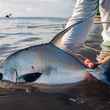
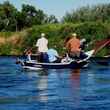












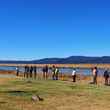
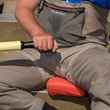



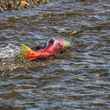
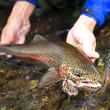
Comments
Steve Erickson replied on Permalink
How do you attach 10# chameleon to rod tip?
Michael Hanslits replied on Permalink
Tie a slip knot in the rod end of the 10# Maxima, and put the Lilian at rod tip through the loop of slip knot. Can tie overhand knot at end of Lilian if the line pulls off.
Bruce Pencek replied on Permalink
Attach the Chameleon the same way we attach any other level line to a tenkara (or related) rod: with a slip knot around the short length of braid ("lilian") that is attached to the rod at the factory.
Guy replied on Permalink
Most all (maybe all) tenkara rods have a piece of woven fabric 'string' attached to the end of the rod. It is called the Lillian. If you type 'lillian tenkara' into a search engine you will see links to web pages that show the knots commonly used to tie the chameleon (or other) level line to the lillian.
Chris Stewart replied on Permalink
Although some tenkara anglers do use furled lines, a level fluorocarbon tenkara line will give you better results when Euro-nymphing. Fluorocarbon weighs less than most furled lines, so it will produce less line sag. It is denser than nylon, so it will be easier to cast than Maxima Chameleon. A fluorocarbon tenkara line is already hi-vis, so you don't need to add a sighter. Thousands of tenkara anglers use hi-vis fluorocarbon line - because it works.
I agree 100% with your premise that a tenkara rod is an excellent tool for Euronymphing. Take the next step and use a level fluorocarbon hi-vis tenkara line also. I think you'll be glad you did.
August Gresens replied on Permalink
Due to an elbow injury I have switched to a tenkara rod for all of my fishing this spring. Previously I was euro-nymphing and created a euro-nymph leader for tenkara.
This change has really been a revelation and I'm honestly not sure if I will go back to a traditional euro-nymph setup for most of my fishing. The biggest difference is to really get a nice drift at distance. The overall setup is also much lighter due to the lack of a reel.
Learning how to land a fish (up to 17 inch brown for me) has been less of a challenge than I would have thought. It has forced me, however, to get much better at using the rod to fight the fish and strategize about how to land it.
This is so good that I would not be surprised if this becomes the next big thing.
Thanks
Karin Miller replied on Permalink
Euro and Czech nymphing pairs perfectly with tenkara rods and one company, Zen Tenkara has specifically designed a tenkara rod for these applications - the Zen Suimenka Tenkara Rod. Its great to see fly anglers opening up and giving the tenkara method a chance. Glad to hear all the positive comments.
Anonymous replied on Permalink
Great article and very helpful to put my tankara to more use! Bummed to see product links go to Amazon.
Pages